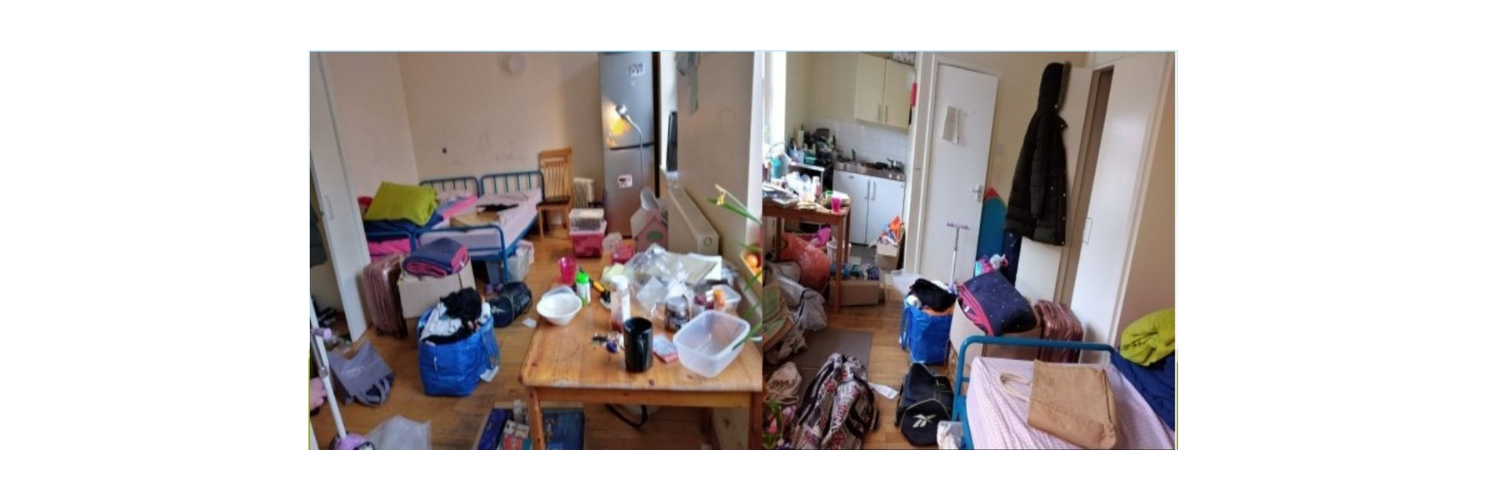Within many high-income countries such as the UK, homelessness is rising. This includes increasing numbers of women, children and families, with many spending months and years in temporary accommodation. Associate Professor Yvonne K. Parry, College of Nursing and Health Sciences, Flinders University, Professor Monica Lakhanpaul and Marta Koch, UCL Great Ormond Institute of Child Health, Population, Policy and Practice Research and Teaching Department, discuss how homelessness is affecting pregnant women and families and highlight how maternity services and other health and social care staff may provide better support.
_________________________________________________
Why does housing matter when it comes to supporting mothers and children?
The interconnection of child development across so many aspects of adulthood is well understood by professionals in medicine, midwifery and nursing. This complexity and interconnections between healthcare and services is impacted by the provision of housing. Housing is a basic human right and lack of adequate housing can greatly impact human dignity. Yet within the UK and other high-income (HI) countries, homelessness is an increasing reality for many infants, children and their families. In the UK, 64% of households living in Temporary Accommodation (TA) are families, and in Australia, 1 in 5 children under the age of 5 spend time with their family in homelessness. This makes housing insecurity and risk of homelessness a rising concern for midwives and maternity healthcare professionals. It is well known that the first 5 years of a child’s development is imperative for lifelong cognitive development, health, social connection formation and educational attainment.
Pregnant women, infants and children are a population uniquely highly-vulnerable to housing insecurity due to increased risk of domestic violence, family breakdown and the fact that the majority of women are less likely to be homeowners in the UK compared to males. This places pregnant women simultaneously at increased risk of homelessness at the same time as having an increased need for a safe, secure home. Therefore, organisations and community-based services are needed to help bridge the social capital gap previously provided by other support such as family or community support.
Negative maternal outcomes for women living in TA include pre-term birth, low birth weight and mental health challenges. A 2019 report from Birth Companions and Birthrights found that housing status was a major factor in human rights support and access to services for mothers and babies, while a 2016 QNI report confirmed significantly poorer outcomes for mothers and infants who are living in TA.
The author’s own research at University College London has found that infants living in Temporary Accommodation (TA) are at a much higher risk of injury, illness and developmental delay. Developmentally, infants and children living in TA, have worse outcomes than children living in poverty, and lower access to healthcare, including antenatal and postpartum care. In terms of environmental factors, temporary accommodation is often crowded and does not meet the needs of infant and child development. Infants and mothers in the UK living in TA can be exposed to damp and mouldy housing with increased incidence of chest infection and asthma, poor nutrition, poor sleep patterns, higher risk of mental health issues and impaired mother-infant bonding. An infant’s cognitive development can also be delayed and the child is a higher risk of developing behavioural issues.
That said, temporary accommodation can be better than some alternatives. Some families describe having to use public toilets as facilities to help with infant bathing or spending the days in shopping centres to use those facilities. As a quote from a young, employed family reveals, “Me [mum] and bubs would go to the local shops all day. We were sleeping in our car and someone threw a brick through the window just missing our baby [6 month old]… even the motel is better than that… we need to leave the motel at 10am and come back at 4pm [if they were approved for another night’s stay].”
With an increasing number of infants and children living in insecure housing, overcrowded spaces with a lack of privacy or security, or having to move often between accommodation and struggling with routines, there is an immediate need for appropriate intervention and long-term solutions. Simply put, this reliance on TA is not a long-term solution for women and children.
Within the UK, family homelessness is rising and recent findings from Shelter show that at least 354,000 people in England, including 161,500 children, at the end of 2024 – a shocking increase of 14%, 44,500 people in one year – were living in temporary homeless accommodation, so this has become a long-term reality for many pregnant women and children. Furthermore, a recent report by Shelter Scotland and Engender identified a lack of gendered understandings of homelessness. Homeless services are primarily designed around the needs of male street sleepers because women are still ‘largely invisible’ in homeless data. This means homeless services and TA continue to fail to meet the needs of pregnant women and children in TA.
What can maternity health services and midwives do to help?
Maternity health services and midwives need to be aware of the poor housing standards and living conditions in TA to help reduce the multiple barriers families can face when engaging with health services. A recent infographic, developed from qualitative research with pregnant mothers experiencing homelessness, highlights key pregnancy health impacts from living in TA, key barriers to accessing maternity care whilst homeless and identifies what pregnant mothers need from their midwifery care. Identifying barriers to accessing healthcare whilst homeless and living long-term in TA can help midwives deliver more person-centred care that adapts the service to the individual woman and her complex circumstances. Please see a recent infographic of how midwives can support pregnant women experiencing homelessness. Recent research has highlighted successful clinical examples of maternity healthcare professionals liaising between GP’s and homeless families to overcome these system barriers. Notably, enhancing this empathetic approach to supporting homeless pregnant women who disengage or do not attend routine appointments means looking towards the system level for barriers, not just the individual level.
In addition, maternity healthcare professionals need to engage and liaise closely with third- sector organisations to reduce barriers to accessing care. Research shows that such embedded models of care can significantly improve health outcomes for infants and children. Maternity services such as antenatal care should create partnerships with homelessness services as a method of ensuring that infants and families remain connected to the holistic healthcare that midwifery can provide.
 Likewise, homelessness service and researcher partnerships should be set up to address the deficit in health connections and help link families to holistic healthcare hubs embedded in the homelessness service. As emphasised by paediatric-trained Nurse and Midwife Dr. Parry, one of the co-authors of this article: “We think a radical, back-to-basics approach is needed to take health services to children and families experiencing homelessness, rather than expecting families experiencing the challenges of homelessness to face the added challenge of navigating the health system in a quest for child-specific services. We need to ensure that the developmental needs of children are better recognised and met in homelessness services to reduce the number of cases falling through the cracks. Young children experiencing homelessness are at serious risk of missing out on vital support and developing long-term developmental issues, because existing [homelessness] services are largely adult-focused and disconnected from the health sector.”
Likewise, homelessness service and researcher partnerships should be set up to address the deficit in health connections and help link families to holistic healthcare hubs embedded in the homelessness service. As emphasised by paediatric-trained Nurse and Midwife Dr. Parry, one of the co-authors of this article: “We think a radical, back-to-basics approach is needed to take health services to children and families experiencing homelessness, rather than expecting families experiencing the challenges of homelessness to face the added challenge of navigating the health system in a quest for child-specific services. We need to ensure that the developmental needs of children are better recognised and met in homelessness services to reduce the number of cases falling through the cracks. Young children experiencing homelessness are at serious risk of missing out on vital support and developing long-term developmental issues, because existing [homelessness] services are largely adult-focused and disconnected from the health sector.”
Call to action
A radical, back-to-basics approach recognising the holistic developmental needs of children is needed to take maternity and midwifery and other health and social care services directly to children and families experiencing homelessness, rather than expecting families experiencing the challenges of homelessness to navigate the health system without tailored support when encountering system-level barriers.
Acknowledgements
The authors would like to thank Sara Cumming, Postdoctoral research fellow, Mother and Infant Research Unit, Dundee, and Professor Nadia Svirydzenka , De Montfort University – Champions co- lead and the Champions team, for their help with editing this article.
References
Ankers M, Parry Y. (2021). Insecure housing and overcrowding risk children’s health. But we’ve found a way to help. The Conversation UK Available at: https://theconversation.com/insecure-housing-and-overcrowding-risk-childrens-health-but-weve-found-a-way-to-help-160692
Birth Companions and Birthrights. (2019). Holding it all together: Understanding how far the human rights of women facing disadvantage are respected during pregnancy, birth and postnatal care. Available at: https://www.birthrights.org.uk/wp-content/uploads/2019/09/Holding-it-all-together-Full-report-FINAL-Action-Plan.pdf
Green JM, Fabricant SP, Duval CJ, et al (2023). Trends, Characteristics, and Maternal Morbidity Associated With Unhoused Status in Pregnancy. JAMA Netw Open. 3;6(7):e2326352. doi: 10.1001/jamanetworkopen.2023.26352
Kolk TA, Nath S, Howard LM, et al (2021). The association between maternal lifetime interpersonal trauma experience and perceived mother-infant bonding. J Affect Disord. Nov 1;294:117-127. doi: 10.1016/j.jad.2021.06.069
Parry YK, Ankers M, Sivertsen N, Willis E. (2022). Where is community during COVID-19? The experiences of families living in housing insecurity, Health and Social Care in the community. Nov. Available at: https://doi.org/10.1111/hsc.13645
Parry YK, Grant J, Burke L. (2016). A scoping study: children, policy and cultural shifts in homelessness services in South Australia: are children still falling through the gaps? Health Soc Care Community. 2016 Sep;24(5):e1-e10. doi: 10.1111/hsc.12309
Parry YK, Harryba S, Horsfall S. (2015). Improving outcomes for families experiencing homelessness: Working together as multi-disciplinary teams to increase health outcomes for children and families. Parity, 28(9), 71-72. Available at: https://researchnow.flinders.edu.au/en/publications/improving-outcomes-for-families-experiencing-homelessness-working
Parry YK, Willis E, Kendall S, Marriott R, Sivertsen N, Bell A. (2020). Addressing the gaps in health for children, Innovative Health Service delivery: Enhancing lifelong development and the health and wellbeing of marginalised children 0 to 18 years. Flinders University Commissioned Report. College of Nursing and Health Sciences. Available at: https://researchnow.flinders.edu.au/en/publications/addressing-the-gaps-in-health-for-children-innovative-health-serv
QNI. (2016). The impact of homelessness on babies and their families, NSPCC. Learning Resource for the Homeless Health Network. Available at: https://www.qni.org.uk/wp-content/uploads/2016/09/homelessness_babies_families.pdf
Rosenthal DM, Schoenthaler A, Heys M, et al (2023). How does living in temporary accommodation and the COVID-19 pandemic impact under 5s’ healthcare access and health outcomes? A qualitative study of key professionals in a socially and ethnically diverse and deprived area of London. International Journal of Environmental Research and Public Health. 2023; 20(2):1300. doi: 10.3390/ijerph20021300
Rosenthal DM, Ucci M, Heys M, et al (2022). A citizen science approach to identifying indoor environmental barriers to optimal health for under 5s experiencing homelessness in temporary accommodation. Int J Environ Res Public Health. 2022;19(7):3976. doi: 10.3390/ijerph19073976
Shelter Scotland and Engender. (2024). Gender and the housing emergency.
Tu Y, Sarkar K, Svirydzenka N, et al (2024). Interventions to promote the health and well-being of children under 5s experiencing homelessness in high-income countries: a scoping review. BMJ Open 2024;14:e076492. doi: 10.1136/bmjopen-2023-076492
Authors:
Associate Professor Yvonne K. Parry 1,2
Professor Monica Lakhanpaul 2
Marta Koch 2
1. Flinders University, College of Nursing and Health Sciences, South Australia. yvonne.parry@flinders.edu.au
2. UCL Great Ormond Institute of Child Health, University College London, London UK.
Author photos:
 February 2025
February 2025


